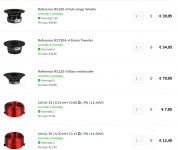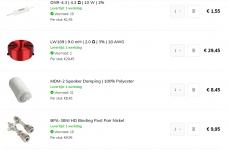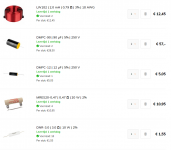Hey,
I am building 3 way speakers, and after a long design process i have selected these parts. I decided to build my own crossover. See the pictures for the parts list and the crossover design. Would love you guys feedback and comments on my selection. Do you think it would work? And do you think building my own crossover is a good idea or should buy a premade?
Thanks in advance!
I am building 3 way speakers, and after a long design process i have selected these parts. I decided to build my own crossover. See the pictures for the parts list and the crossover design. Would love you guys feedback and comments on my selection. Do you think it would work? And do you think building my own crossover is a good idea or should buy a premade?
Thanks in advance!
Attachments
Last edited by a moderator:
Welcome MaartenAfro!
It looks like the images are showing as broken links so until they work we can't really comment on much.
The one thing I can say is don't use a premade crossover - crossovers really need to be customized for the specific drivers and application they're beong used in.
Additionally, most people here will recommend starting with a 2-way instead of a 3-way to simplify things more, and most will also recommend starting with a kit designed by a proven designer instead of a full new design so that you can learn from the kit... I didn't follow the kit advice myself though and ended up with a decently nice set of bookshelf speakers using extremely cheap drivers 😀
It looks like the images are showing as broken links so until they work we can't really comment on much.
The one thing I can say is don't use a premade crossover - crossovers really need to be customized for the specific drivers and application they're beong used in.
Additionally, most people here will recommend starting with a 2-way instead of a 3-way to simplify things more, and most will also recommend starting with a kit designed by a proven designer instead of a full new design so that you can learn from the kit... I didn't follow the kit advice myself though and ended up with a decently nice set of bookshelf speakers using extremely cheap drivers 😀
1, 3 open in a new tab, 2 with/without .img doesn't exist.
Looks good at a glance, but no passive XO 'expert', though definitely DIY XO even if doing just a basic 'textbook' one to ensure good quality/matching components.
GM
Looks good at a glance, but no passive XO 'expert', though definitely DIY XO even if doing just a basic 'textbook' one to ensure good quality/matching components.
GM
Thanks GM, good call on the new tab.
Crossover design looks solid as long as the actual drivers match the simulations used for the design (assuming you used simulations and not measurements). One thing to consider is that the impedance drops to around 3 ohms between 500-1000 Hz, so make sure your amplifier can handle a 4 ohm nominal load.
I used the RS100P-4 in a design recently and it seems to be a good performer.
Crossover design looks solid as long as the actual drivers match the simulations used for the design (assuming you used simulations and not measurements). One thing to consider is that the impedance drops to around 3 ohms between 500-1000 Hz, so make sure your amplifier can handle a 4 ohm nominal load.
I used the RS100P-4 in a design recently and it seems to be a good performer.
Just curious why you add 4,5 ohm in series with woofer.
Typically being the least efficient unit and handling the most power, that´s unusual.
If needed, *other* units are attenuated to match woofer.
Typically being the least efficient unit and handling the most power, that´s unusual.
If needed, *other* units are attenuated to match woofer.
Probably because the rs225p-8 shows higher sensitivity on its frequency response graph on the data sheet than the rs100p-4.
MaartenAfro, I suggest researching baffle step compensation before ordering parts and considering whether your application requires it, because if it does then you'll want to make some crossover changes.
MaartenAfro, I suggest researching baffle step compensation before ordering parts and considering whether your application requires it, because if it does then you'll want to make some crossover changes.
All Z planes are now on 0 in your VCad sim. That is not going to work. Establish the relative driver depth first of all before starting to sim. You have to measure the raw inbox drivers in box, first of all individually. Then measure all 3 again, parallel wired, and simultaneously driven with the mic in one point. Do not move the mic. Then comes the trial and error process of step by step adding Z plane depth for woofer and mid until the combined SPL matches the measured combined SPL.
Yes, I 2nd the idea that the series R on the woofer is a no-no.
I think I would also move the lower xo point up about an octave. Upper one looks ok although it could possibly be a little lower if desired.
Consider an iron core inductor for your woofer too. Besides the expense, the resistance of that coil is too high.
And yes, for accuracy when just using the spec sheet info (as apposed to in-cab measurements), your frd and zma files should include box effects, baffle diffraction effects and x, y and z offset info, all where applicable.
If your speakers will be in a position where they won't lose 6dB to full baffle step loss (ie. right up against a wall), then your mid driver selection is not a good one due to the sensitivity mismatch.
I think I would also move the lower xo point up about an octave. Upper one looks ok although it could possibly be a little lower if desired.
Consider an iron core inductor for your woofer too. Besides the expense, the resistance of that coil is too high.
And yes, for accuracy when just using the spec sheet info (as apposed to in-cab measurements), your frd and zma files should include box effects, baffle diffraction effects and x, y and z offset info, all where applicable.
If your speakers will be in a position where they won't lose 6dB to full baffle step loss (ie. right up against a wall), then your mid driver selection is not a good one due to the sensitivity mismatch.
- Home
- Loudspeakers
- Multi-Way
- Need help with building speakers



